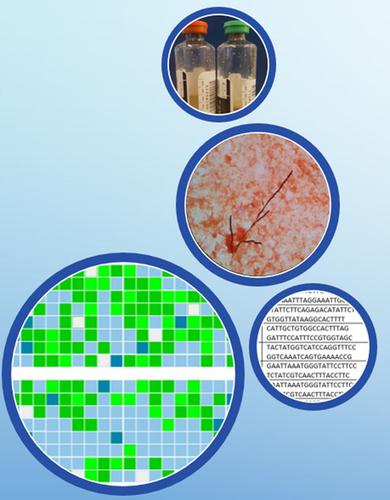当前位置:
X-MOL 学术
›
Lett. Appl. Microbiol.
›
论文详情
Our official English website, www.x-mol.net, welcomes your
feedback! (Note: you will need to create a separate account there.)
Targeted amplification and MinION nanopore sequencing of key azole and echinocandin resistance determinants of clinically relevant Candida spp. from blood culture bottles
Letters in Applied Microbiology ( IF 2.0 ) Pub Date : 2021-06-01 , DOI: 10.1111/lam.13516 K L Chew 1 , S Octavia 2 , R Jureen 1 , R T P Lin 1, 2 , J W P Teo 1
Letters in Applied Microbiology ( IF 2.0 ) Pub Date : 2021-06-01 , DOI: 10.1111/lam.13516 K L Chew 1 , S Octavia 2 , R Jureen 1 , R T P Lin 1, 2 , J W P Teo 1
Affiliation

|
The objective of the study was to evaluate the use of targeted multiplex Nanopore MinION amplicon re-sequencing of key Candida spp. from blood culture bottles to identify azole and echinocandin resistance associated SNPs. Targeted PCR amplification of azole (ERG11 and ERG3) and echinocandin (FKS) resistance-associated loci was performed on positive blood culture media. Sequencing was performed using MinION nanopore device with R9.4.1 Flow Cells. Twenty-eight spiked blood cultures (ATCC strains and clinical isolates) and 12 prospectively collected positive blood cultures with candidaemia were included. Isolate species included Candida albicans, Candida glabrata, Candida krusei, Candida parapsilosis, Candida tropicalis and Candida auris. SNPs that were identified on ERG and FKS genes using Snippy tool and CLC Genomic Workbench were correlated with phenotypic testing by broth microdilution (YeastOne™ Sensititre). Illumina whole-genome-sequencing and Sanger-sequencing were also performed as confirmatory testing of the mutations identified from nanopore sequencing data. There was a perfect agreement of the resistance-associated mutations detected by MinION-nanopore-sequencing compared to phenotypic testing for acquired resistance (16 with azole resistance; 3 with echinocandin resistance), and perfect concordance of the nanopore sequence mutations to Illumina and Sanger data. Mutations with no known association with phenotypic drug resistance and novel mutations were also detected.
中文翻译:

临床相关念珠菌属关键唑类和棘白菌素耐药性决定因素的靶向扩增和 MinION 纳米孔测序。从血培养瓶
该研究的目的是评估关键念珠菌属的靶向多重 Nanopore MinION 扩增子重测序的使用。从血培养瓶中鉴定唑类和棘白菌素抗性相关的 SNP。在阳性血培养基上对唑类(ERG11和ERG3)和棘白菌素(FKS)抗性相关基因座进行靶向 PCR 扩增。使用带有 R9.4.1 Flow Cell 的 MinION 纳米孔装置进行测序。包括 28 份加标血培养物(ATCC 菌株和临床分离株)和 12 份前瞻性收集的具有念珠菌血症的阳性血培养物。分离菌种包括白色念珠菌、光滑念珠菌、克柔念珠菌、近平滑念珠菌,热带念珠菌和耳念珠菌. 使用 Snippy 工具和 CLC Genomic Workbench 在 ERG 和 FKS 基因上鉴定的 SNP 与通过肉汤微量稀释 (YeastOne™ Sensititre) 进行的表型测试相关联。Illumina 全基因组测序和 Sanger 测序也用于验证从纳米孔测序数据中识别出的突变。与获得性耐药的表型测试相比,MinION 纳米孔测序检测到的耐药相关突变完全一致(16 个唑类耐药;3 个棘白菌素耐药),纳米孔序列突变与 Illumina 和 Sanger 数据完全一致. 还检测到与表型耐药性和新突变没有已知关联的突变。
更新日期:2021-06-01
中文翻译:

临床相关念珠菌属关键唑类和棘白菌素耐药性决定因素的靶向扩增和 MinION 纳米孔测序。从血培养瓶
该研究的目的是评估关键念珠菌属的靶向多重 Nanopore MinION 扩增子重测序的使用。从血培养瓶中鉴定唑类和棘白菌素抗性相关的 SNP。在阳性血培养基上对唑类(ERG11和ERG3)和棘白菌素(FKS)抗性相关基因座进行靶向 PCR 扩增。使用带有 R9.4.1 Flow Cell 的 MinION 纳米孔装置进行测序。包括 28 份加标血培养物(ATCC 菌株和临床分离株)和 12 份前瞻性收集的具有念珠菌血症的阳性血培养物。分离菌种包括白色念珠菌、光滑念珠菌、克柔念珠菌、近平滑念珠菌,热带念珠菌和耳念珠菌. 使用 Snippy 工具和 CLC Genomic Workbench 在 ERG 和 FKS 基因上鉴定的 SNP 与通过肉汤微量稀释 (YeastOne™ Sensititre) 进行的表型测试相关联。Illumina 全基因组测序和 Sanger 测序也用于验证从纳米孔测序数据中识别出的突变。与获得性耐药的表型测试相比,MinION 纳米孔测序检测到的耐药相关突变完全一致(16 个唑类耐药;3 个棘白菌素耐药),纳米孔序列突变与 Illumina 和 Sanger 数据完全一致. 还检测到与表型耐药性和新突变没有已知关联的突变。











































 京公网安备 11010802027423号
京公网安备 11010802027423号